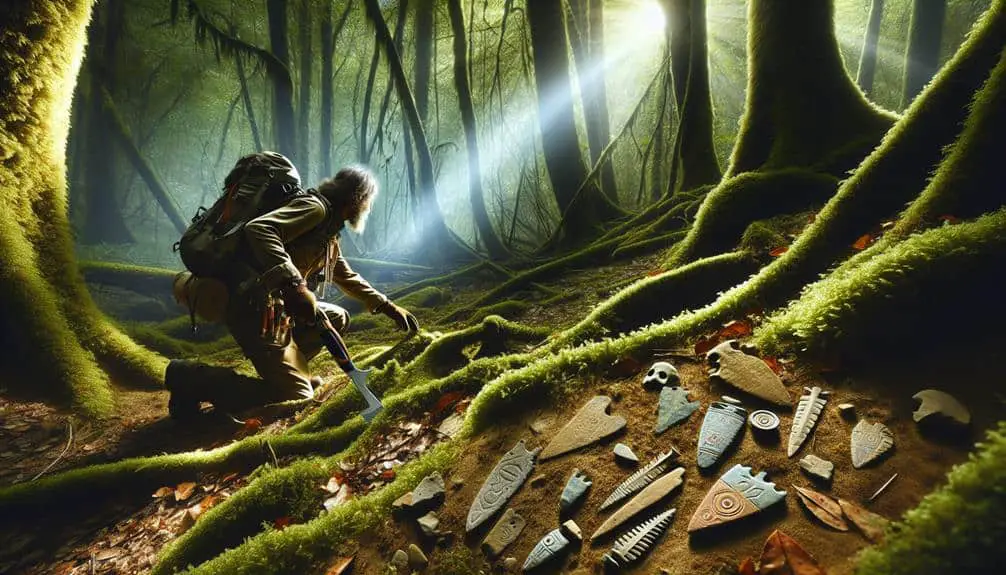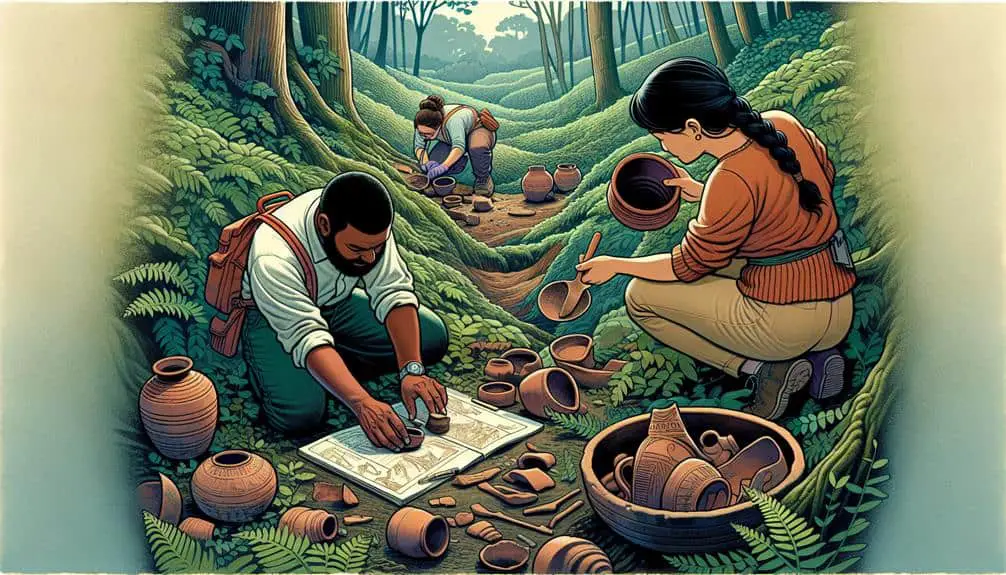Discover Tribal Histories to understand origins and cultural context. Connect with Indigenous locals for insights and sensitivity. Respect Sacred Sites with reverence and avoid disturbing them. Document Discoveries carefully for posterity and understanding. Interact with Tribal Communities to promote respect and collaboration. These five tips will assist you in exploring Native American settlement remnants respectfully and informatively.
Key Points
- Understand cultural significance and historical context for meaningful exploration.
- Connect with Indigenous community members for local insights and guidance.
- Approach sacred sites with reverence and respect, acknowledging their spiritual importance.
- Document discoveries to preserve artifacts and insights into Native American history.
- Engage with tribal communities for mutual understanding and cultural sensitivity.
Research Tribal Histories
To understand the origins and significance of Native American settlement remnants, researching tribal histories provides essential insights into their cultural and historical context. Study customs and traditions passed down through generations to gain a deeper understanding of the way of life within these communities.
Explore archaeology to uncover artifacts and structures that reveal how these settlements were organized and utilized. Preservation efforts play an important role in maintaining these sites for future generations to learn from and appreciate.
Seek Local Guidance
For those interested in exploring further to understand Native American settlement remnants, local guidance serves as a valuable resource for exploring the intricacies of these historical sites. Seeking the expertise of local experts can provide you with a deeper understanding of the cultural significance and historical context of these locations.
Here are some tips to help you make the most out of seeking local guidance:
- Connect with Indigenous Community Members: Building relationships with members of the local Indigenous community can offer unique perspectives and insights into the settlement remnants you're exploring.
- Practice Cultural Sensitivity: Approach interactions with cultural sensitivity, respecting the traditions and beliefs of the Indigenous peoples whose lands you're visiting.
- Listen and Learn: Be open to listening and learning from the stories and knowledge shared by local experts, as they hold valuable information that can enrich your experience and understanding of Native American settlement remnants.
Respect Sacred Sites
When exploring Native American settlement remnants, it's important to approach sacred sites with reverence and respect. These sites hold deep cultural preservation and spiritual significance for Native American communities. To show respect, it's vital to understand the historical and religious importance these sites hold for the descendants of the indigenous people who once thrived there.
Cultural preservation is paramount when encountering sacred sites. Treat these locations as you'd a place of worship, showing the same level of respect and etiquette. Avoid touching, moving, or taking anything from these sites. Even simple acts like picking up a rock or disturbing the soil can disrupt the delicate balance and significance of the area.
Understanding the spiritual significance of these sites is key to respecting them properly. Recognize that these locations aren't simply historical artifacts but living, breathing representations of Native American spirituality. By honoring and protecting these sacred sites, you contribute to the preservation of indigenous culture and the continuation of traditions that have withstood the test of time.
Document Discoveries
Exploring Native American settlement remnants may lead to fascinating document discoveries that shed light on the historical context and cultural practices of the indigenous communities that once inhabited these sites.
As you dive into these remnants, keep in mind the following:
- Unearthed archaeological artifacts provide vital connections to the past, allowing you to visualize the daily lives and rituals of Native American tribes.
- Preservation efforts play an essential role in safeguarding these document discoveries for future generations, ensuring that the stories and knowledge embedded within them aren't lost to time.
- Each document discovery offers a unique glimpse into the rich tapestry of Native American history, offering a deeper understanding of the traditions and customs that shaped these communities.
Engage With Tribal Communities
Engaging with tribal communities when exploring Native American settlement remnants is essential for fostering mutual understanding and respect for their cultural heritage. Community collaboration plays an important role in ensuring that your exploration is conducted with cultural sensitivity.
Before visiting any site, make an effort to reach out to the relevant tribal authorities or cultural resource management offices. Establishing this initial contact can provide you with valuable insights, guidance, and potentially even permission to access certain areas.
When engaging with tribal communities, it's important to listen actively and respectfully to their perspectives and concerns. Remember that these sites hold significant cultural and historical importance, and approaching them with sensitivity is paramount.
Frequently Asked Questions
How Can I Ensure That I Am Not Disturbing Any Sacred Burial Grounds While Exploring Native American Settlement Remnants?
Make sure you're not disturbing sacred burial grounds by respecting boundaries and practicing cultural sensitivity. Stay on marked paths, avoid collecting artifacts, and leave everything as you found it. By being mindful, you show respect.
Are There Any Specific Protocols or Customs That I Should Be Aware of When Documenting My Discoveries at These Sites?
When documenting at these sites, understanding boundaries is essential. Cultivate cultural sensitivity by respecting traditions. Consider the impact of your actions. By honoring customs, you preserve the legacy of those who came before.
What Steps Can I Take to Engage With Tribal Communities in a Respectful and Meaningful Way While Exploring Native American Settlement Remnants?
To engage respectfully with tribal communities while exploring native American settlement remnants, consider starting by acknowledging their sovereignty, history, and culture. Building relationships requires active listening, openness, and willingness to learn from their perspectives and experiences.
How Can I Educate Myself About the Specific Histories and Cultures of the Tribes That Once Inhabited the Areas Where I Am Exploring?
To truly explore understanding histories and cultural appreciation of tribes in explored areas, immerse yourself in their stories, traditions, and struggles. Listen, read, visit museums, engage with tribal members, and embrace diverse perspectives.
You can connect with community partnerships and educational resources to guide your journey through Native American settlement remnants. By prioritizing cultural sensitivity and supporting preservation efforts, you can gain valuable insights and navigate with respect.



